Excerpts from Jim Conrad's
Naturalist Newsletter
Issued February 13, 2020 from the forest just west of Tepakán; elev. ~9m (~30 ft), N21.053°, W89.052°; north-central Yucatán state, MÉXICO
DANGLING COTTON BALLS OF POCHOTE/ SCHOTT'S CEIBA
Out in the forest and along forest edges nowadays you can see big cotton balls hanging on fair-sized trees, shown below.
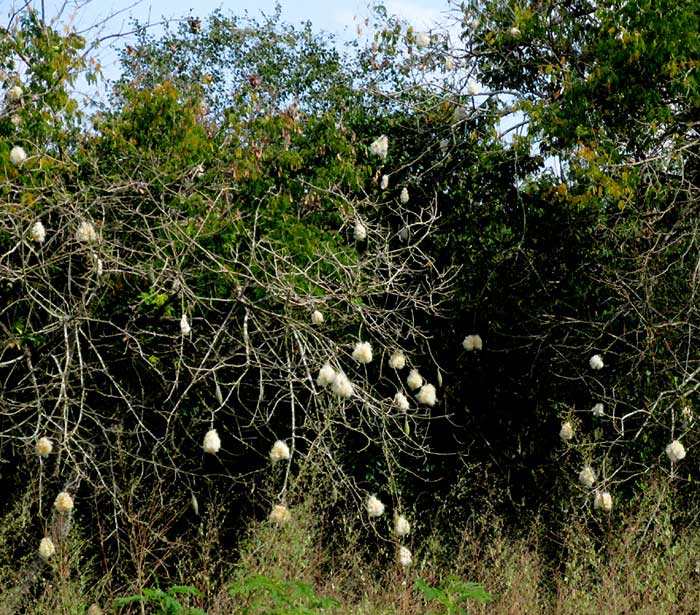
You've heard of kapok, which is the cottony fiber surrounding seeds in matured ceiba fruits. The cotton balls are produced by a kind of ceiba tree, but not the big, majestic Ceiba we usually think of. It's a second species of the four ceiba species occurring in Mexico, three in the Yucatan. It's CEIBA SCHOTTII so I call it Schott's Ceiba, while the local Maya call it Pochote, which also is used for the other ceiba species occurring farther south in the Peninsula where it's rainier.
Beneath these fairly common trees the leaf litter now is covered with cottony fluff, as shown below:
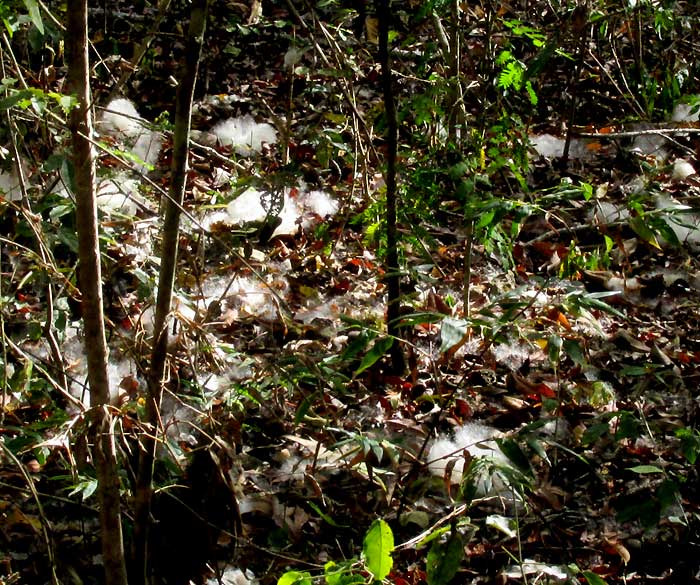
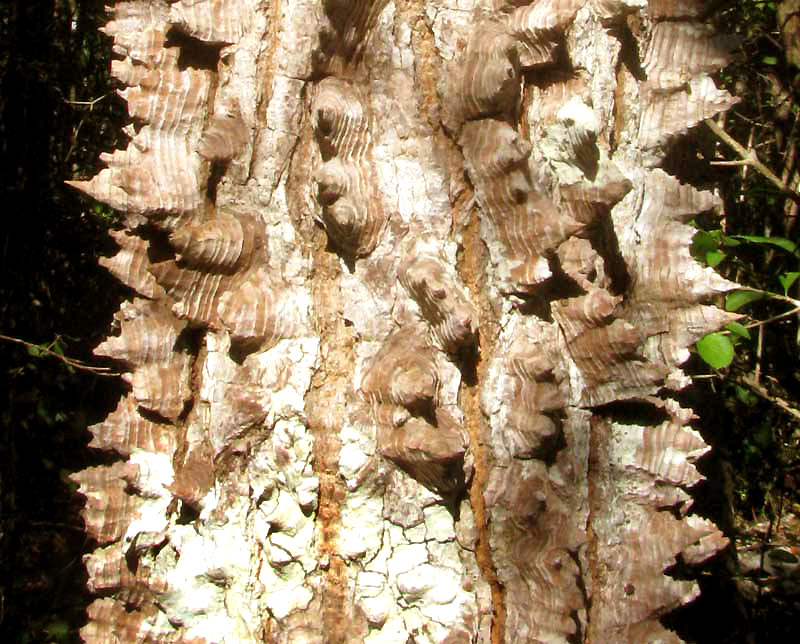
from the January 15, 2012 Newsletter issued from Hacienda Chichen Resort beside Chichén Itzá Ruins; limestone bedrock; elevation ~39m (~128ft), N20.675°, W88.569°; central Yucatán state, MÉXICO
SCHOTT'S CEIBA
In Mexico we have four species of Ceibas of which three occur in the Yucatan. There's the famous C. pentandra, plus C. aesculifolia and C.schottii. C. aesculifolia is mostly on the western side of the peninsula. Here at Chichén Itzá I'm finding only two species, the big C. pentandra and, for lack of a better name, what I call Schott's Ceiba, CEIBA SCHOTTII. I've seen the name Vanilla Silk Cotton Tree used for the species but I'm not sure anyone really recognizes that. Schott's Ceiba is endemic to the Yucatán Peninsula and northern Guatemala.
Nowadays Schott's Ceiba is fruiting, as shown below:
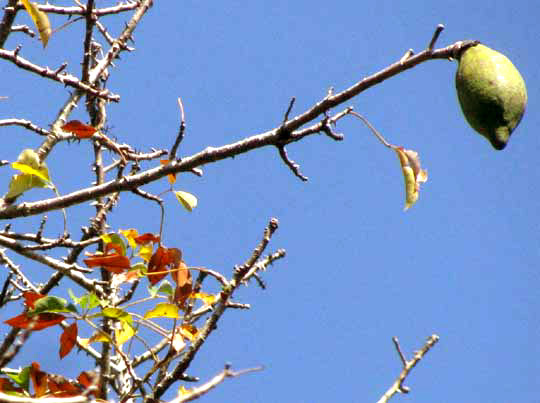
In that picture the four-inch-long (10cm), nipple-bottomed fruit suspends from the tip of a limb from which nearly all the leaves have fallen in advance the dryer part of the dry season. Enough leaves remain on other limbs, though, to see that like the giant Ceiba the Schott's Ceiba's leaves are "digitately compound," its three to seven leaflets arising from the petiole's top like fingers from a hand.
Beneath the tree lay fruit, apparently half-eaten by a rodent, prodigiously erupting white fuzz as shown below:
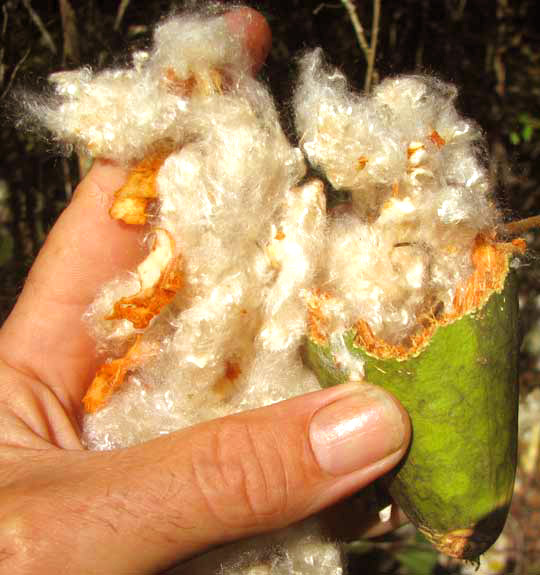
Here you see that Schott's Ceiba, just like the giant Ceiba, embeds its small seeds in abundant kapok fiber. Giant Ceiba kapok I've seen is brown-tinged, however, while Schott's fuzz is pure white. Also the giant's fruits are round bottomed while the Schott fruits I've seen are broadly nippled at their bases.
Schott's Ceiba's trunks are even spinier than the giant's, as shown on a 10-inch wide (25cm) trunk at the top of this page.
Schott's spines sometimes have multiple teeth, show clear layering, and bark between spines is gray -- as opposed to the giant's single teeth with no layering, and often with green bark between spines.
Though Schott's Ceiba grows much smaller than the giant, only to about 26 ft (8m), Schott's bears much larger flowers. Giant Ceiba flower petals are only about two inches long (5cm) while Schott's grow to about seven inches (18cm).
What a treat to meet this interesting local variation on the famous giant Ceiba theme. Also it's good, and unusual, to have found for free on the Internet a comprehensive technical paper in PDF format reviewing all 17 recognized Ceiba species, even including distribution maps for 16 of the species and several drawings. The paper is the 2003 study by Peter Gibbs and João Semir entitled "A Taxonomic Revision of the Genus Ceiba Mill. (Bombacaceae)."
from the March 18, 2012 Newsletter issued from Hacienda Chichen Resort beside Chichén Itzá Ruins; limestone bedrock; elevation ~39m (~128ft), N20.675°, W88.569°; central Yucatán state, MÉXICO
SCHOTT'S CEIBA HEAVY WITH FRUITS
Last Sunday in an abandoned lot in Pisté a cluster of Schott's Ceibas turned up, enabling me to get a better idea of what the tree is like. Most surprising were the nearly spherical, muskmelon-size fruits shown below:
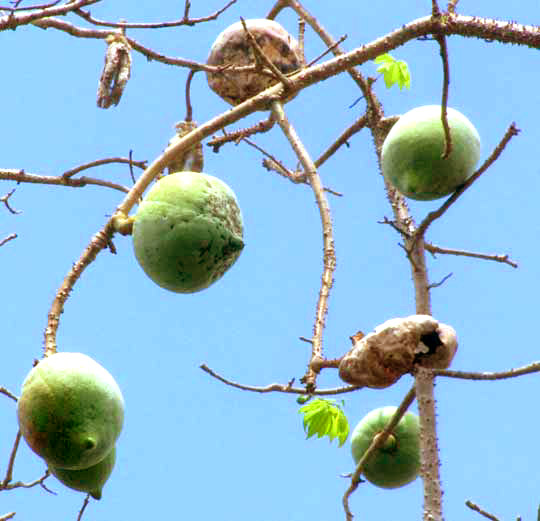
I'd thought the fruits were slenderer. Once the fruits shed their cottony contents, their drying shells warp and wrinkle into odd shapes and remain on the tree awhile, giving the mostly leafless trees a bizarre and unkempt appearance. However, at the tips of certain branches new leaves -- digitately compound with seven or so leaflets -- are unfurling, their pale, springy greenness so promising and nice to see, as shown below:
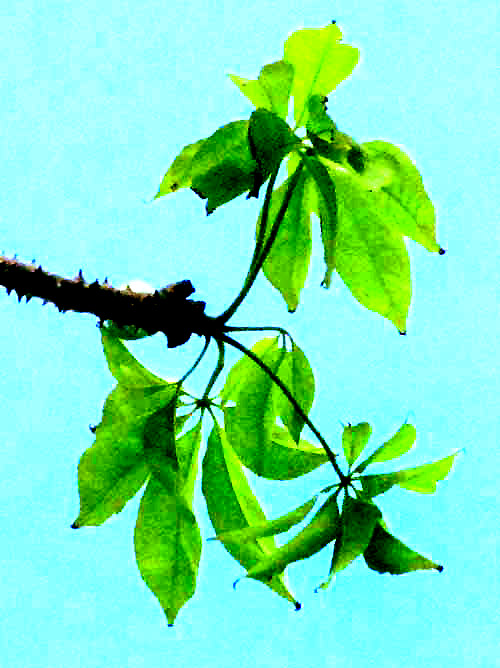
from the August 23, 2015 Newsletter issued from Yaxunah, 20kms southwest of Chichén Itzá; elevation about 300m (100ft), N20.538°, W88.678°, Yucatán, MÉXICO
SCHOTT'S CEIBA FLOWERING
Our 2012 trees, profiled above, were seen during the winter dry season when they bore large pods filled with white fuzz, or kapok fiber. Here at Yaxunah, now during the rainy season, the species is flowering, and I'm surprised to see how different Schott's Ceiba flowers are from those of the big Ceiba pentandra, whose flowers you can see at www.backyardnature.net/n/10/100314cc.jpg.
Compare those small, pinkish flowers with those of a Schott's Ceiba blossom found along a trail, measuring seven inches (18cm) from the calyx base to corolla-lobe tip, shown below:
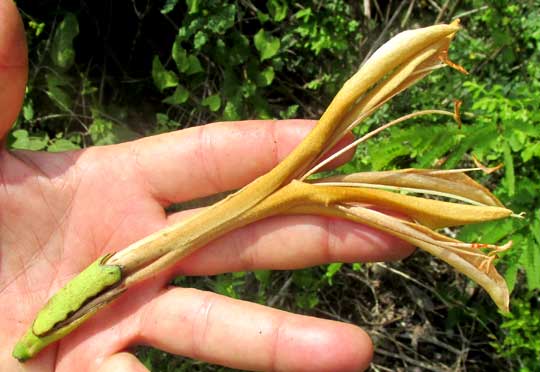
Below, a wilting flower still on a tree better displays the sexual parts:
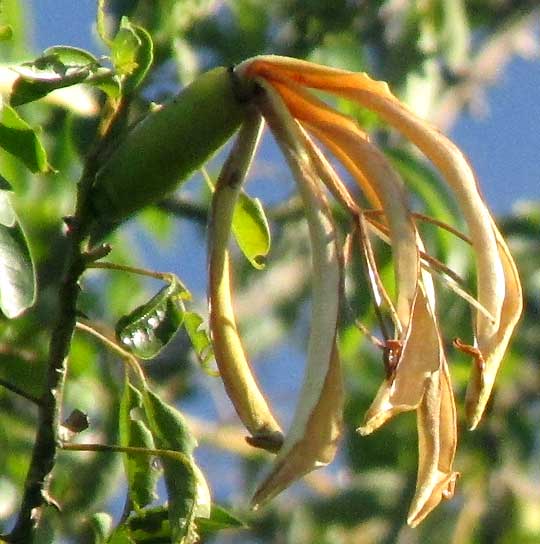
Besides the corolla lobes being much longer and more slender than those of Ceiba pentandra, note that in this flower's center the five stamens join at their filament bases to form a cylindrical "staminal column" around the style's lower half. In flower anatomy, staminal columns are a big deal, and it's interesting that in Ceiba pentandra flowers the columns are hardly noticeable, but in Schott's Ceiba the columns are very well developed. Another curious feature about the genus Ceiba, barely visible in our picture, is that at the tip of each of the five filaments the anthers tend to twist.
A good field mark for Schott's Ceiba is its whitish bark, the vertical ridges of which bear lines of low, broad-based spines. Below you can our Yaxunah tree's paired trunks:
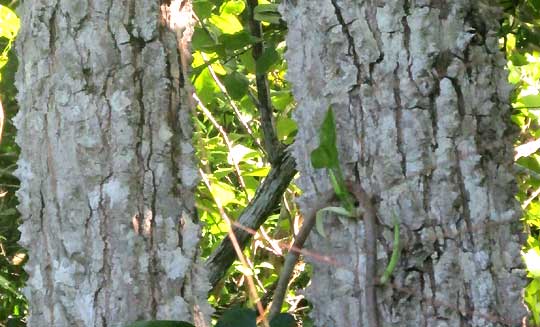
from the September 10, 2017 Newsletter issued from Rancho Regensis north of Valladolid, Yucatán, MÉXICO;
elevation ~40m (~130 ft), N~20.876°, W~88.170°
IN FULL FLOWER
Normally you don't see Schott's Ceiba flowers because they're out of sight, high in the forest's canopy. This week, however, I spotted one through a hole in the canopy, about 20 feet up (6m). It's shown below:
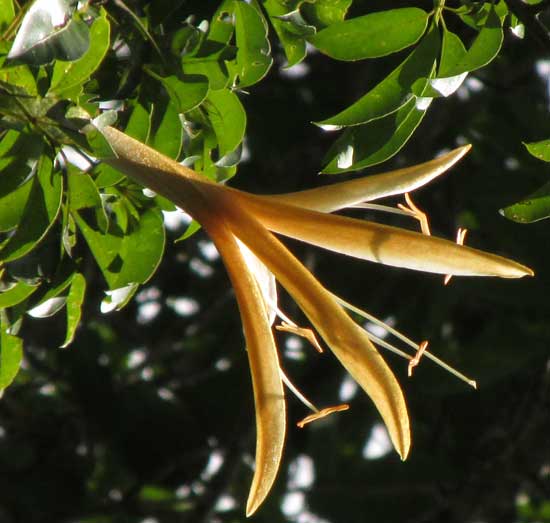
Issued January 20, 2020 from the forest just west of Tepakán; elev. ~9m (~30 ft), N21.053°, W89.052°; north-central Yucatán state, MÉXICO
SCHOTT'S CEIBA TUBEROUS STORAGE STEM
While clearing the rancho's boundary trail I came upon a young Schott's Ceiba sapling. Numerous trees of the species grew nearby so I didn't feel too bad about chopping my mattock into the ground below it, to sever its roots. When I pulled out the stem, I saw what's shown below:
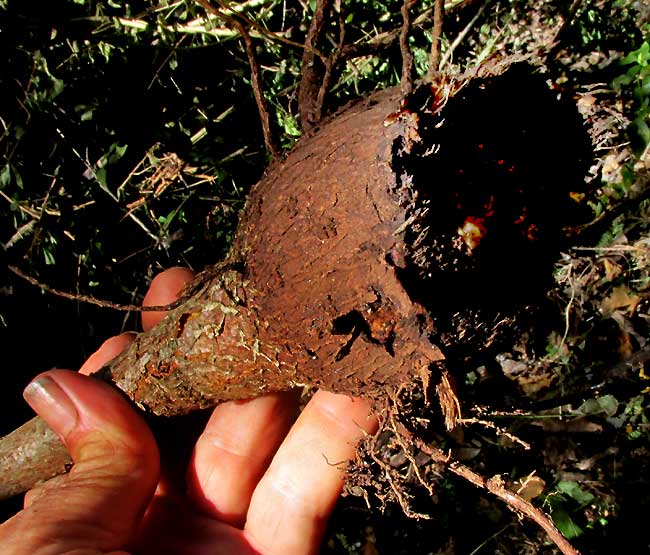
The bulging area, apparently for storing water and carbohydrates, was completely underground.